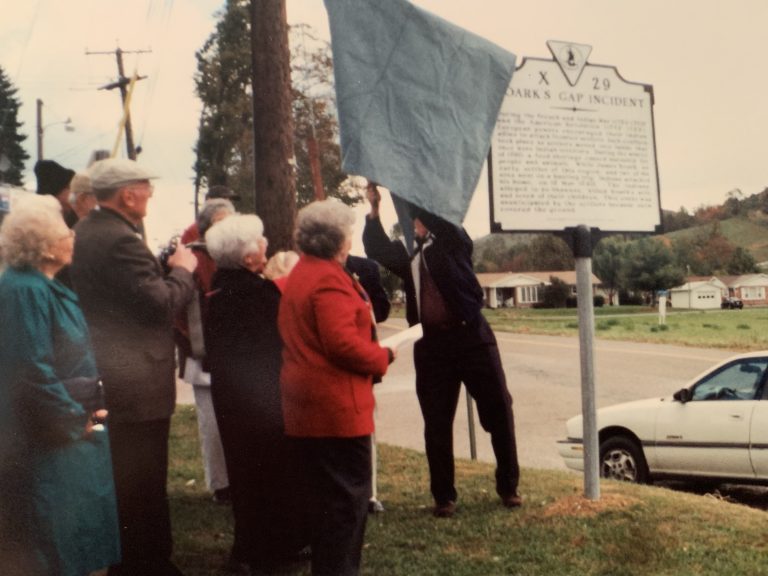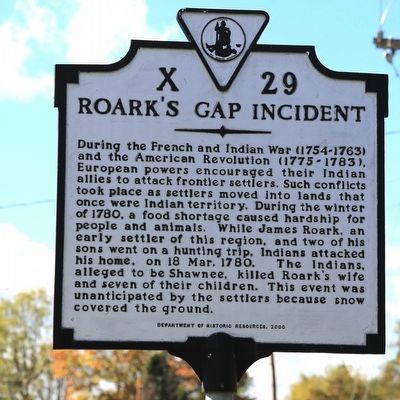Roark’s Gap Incident Historical Marker

On March 18, 1780, the James Roark massacre occurred in the Baptist Valley area of Tazewell County, VA. While James Roark, an early settler of this region, and two of his sons went on a hunting trip, Indians attacked his home. The Indians, alleged to be Shawnee, killed and scalped James’ wife and seven of his children. James, and his oldest son John, were later killed in a battle with the Shawnee Indians. Timothy Roark, Sr., who married Sarah Bolen, was the only family member to live to adulthood and raise a family.
The video clip above is a short clip of DVD #3, created to commemorate this historic event.
You can buy this and other DVD’s the R-CA offers for sale.

Below are historical documents related to the Historical Marker dedication ceremony that have been preserved by members of the R-CA.
Dedication of Historical Marker
by Doris Shropshire Thornton
Thirty-two members of the Roark-Conner Association experienced a dream come true October 9, 2000 near Roark’s Gap in Baptist Valley, Virginia. We gathered with members of the Tazewell County Historical Society to dedicate a historical marker to commemorate the March 18, 1780, massacre of the wife and seven children of our ancestor, James Roark. A skip of snow and cold temperatures heightened the sense of history as we stood around the marker for the unveiling by Chuck Gross, who began this dream for us many years ago.
The marker reads: “Roark’s Gap Incident. During the French and Indian War (1754-1763) and the American Revolution (1775-1783), European powers encouraged their Indian allies to attack frontier settlers. Such conflicts took place as settlers moved into lands that once were Indian territory.
During the winter of 1780, a food shortage caused hardship for people and animals. While James Roark, an early settler of this region, and two of his sons went on a hunting trip, Indians attacked his home, on 18 Mar. 1780. The Indians, alleged to be Shawnee, killed Roark’s wife and seven of his children. This event was unanticipated by the settlers because snow covered the ground.”
The dedication service was held inside the nearby Yost Chapel Freewill Baptist Church due to the extreme cold outside. Dr. Tom Hatcher, President of the Tazewell County Historical Society, brought greetings and commended us for our interest in preserving history and honoring this first documented incident in Tazewell County.
Doris Thornton led the dedication service which honored James Roark and his family by recalling the values that they lived: a commitment to family, a willingness to work, a drive for freedom, a willingness to face risks which they backed up with courage and faith. She recalled the tragedy of this sad family incident resulting from a “clash of cultures” and challenged the group to celebrate their lives by embracing those same values as we face our own “clash of cultures” today. David Roark, our new president, gave a moving prayer to conclude the service.
Following the dedication service, we drove to what is believed to be the James Roark homesite and cemetery. A natural spring borders this property and several members walked down to stand on its banks. We then drove to the lovely home of Dr. and Mrs. Roy Wright which was built in the 1700’s on land that is nearby the James Roark homesite. Mrs. Wright graciously showed us the unusual markings and carved initials she discovered while doing rubbings of some of the original logs. They seem to be a part of the Roark name. It was a hallowed moment to where James Roark himself may have one day stood.
Pisgah Church hosted us for a delicious lunch which was most welcome after our cold travels. John Roark gave a keynote address describing the conditions under which the early settlers lived and challenging us to remember the problems they faced and the hardships that they overcame. He described the ongoing conflicts with the Indians and with the soldiers of the Revolutionary War, describing the massacre and the efforts of James Roark to cope with that tragedy. He encouraged us to remember these pioneers for who they were and what they were “…and to remember their indomitable courage, their enduring fortitude, and their remarkable strength of character.”
John Roark took Chuck Gross’s dream, and with his knowledge and “can do” attitude, coordinated bringing it to life. He was assisted by the research of Pat Surface, of the Tazewell County Historical Society, who found the documentation of the massacre and graciously assisted in the planning for the dedication services. She and other Society members hosted us for a delightful reception the evening prior to the dedication.
We are grateful to each of them for all that they did to assist us in our search for family roots and to celebrate with us in our dedication of the historical marker. We are grateful, also, to the many members of the Roark-Conner Association who generously gave the resources to make this dream a reality.